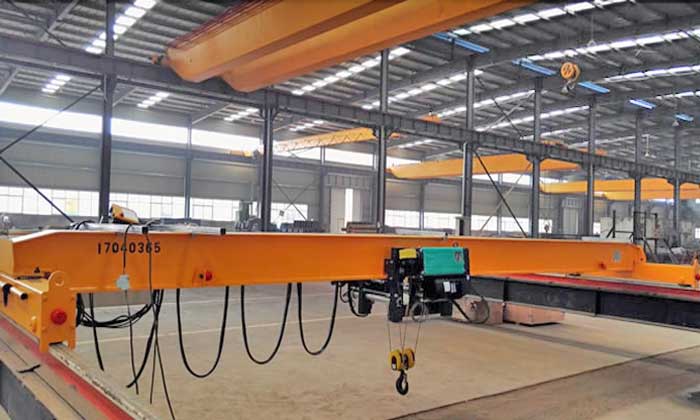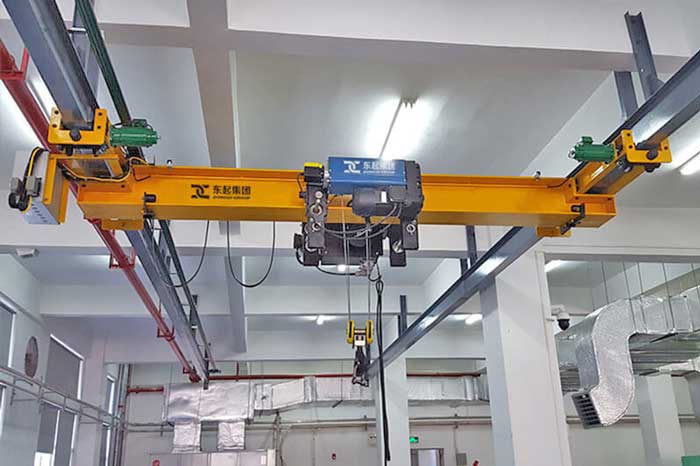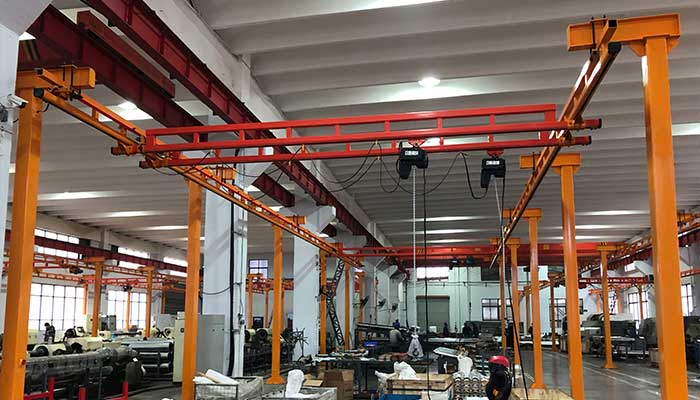Light Duty Overhead Cranes for Sale 1 Ton to 20 Ton
Light duty overhead cranes for sale, from 1 to 20 tons, featuring various types to lighten your lifting expenses.
Light duty overhead cranes are vital tools in various industries, enhancing efficiency and safety in material handling applications. Designed for lighter loads, these cranes are perfect for use in workshops, warehouses, and manufacturing plants. With capacities ranging from 500 kg to 3 tons, they offer versatility to meet diverse operational needs. In this article, we will explore the types, features, applications, and advantages of light duty overhead cranes.
Types of Light Duty Overhead Cranes
Light duty overhead cranes are designed for efficient material handling in various settings. Here’s a look at four popular types:
Top Running Single Girder Electric Chain Overhead Crane
This crane features a single girder that runs along the top of the supporting structure. The electric chain hoist ensures smooth lifting and lowering, making it suitable for medium to large spaces.
European style single girder top running crane
Key Features:
- Load Capacities: Typically ranges from 500 kg to 3 tons.
- Applications: Commonly used in manufacturing and assembly operations.
Single Girder Underslung Crane
Mounted beneath the supporting structure, this crane maximizes overhead space and is perfect for facilities with height restrictions.
underslung overhead crane
Key Features:
- Load Handling Capabilities: Similar to top running cranes, accommodating various loads.
- Ideal Usage Scenarios: Frequently used in assembly lines and light manufacturing.
Freestanding Workstation Overhead Cranes
These cranes feature adjustable designs that allow for customization based on specific needs.
Freestanding Workstation Overhead Cranes
Key Features:
- Load Capacity Range: Generally supports loads from 500 kg to 2 tons.
- Versatility: Suitable for various lifting heights, making them great for different tasks in repair shops and production lines.
Key Features of Light Duty Overhead Cranes
Light duty overhead cranes are designed to optimize operational efficiency, safety, and versatility across various industrial environments. Here’s a detailed look at their key features:
Electric Hoist Systems
Electric hoists serve as the backbone of light duty overhead cranes, offering efficient lifting mechanisms that significantly enhance productivity and reduce manual labor.
- Load Capacities: These cranes typically support loads ranging from 500 kg to 3 tons, making them suitable for a variety of lifting tasks, from moving small parts in assembly lines to handling heavier items in manufacturing.
- Benefits: Electric hoists minimize operator effort by automating the lifting process, which not only increases speed but also reduces the physical strain on workers. This leads to higher productivity and less fatigue, ensuring smoother operations throughout the workday.
Safety Mechanisms
Safety is a critical consideration in any lifting operation, and light duty overhead cranes come equipped with a range of advanced safety features to protect both personnel and equipment.
- Overload Protection: This essential feature prevents the crane from lifting loads that exceed its rated capacity, significantly lowering the risk of equipment failure or accidents. By ensuring that operations remain within safe limits, this mechanism protects the integrity of the crane and the safety of operators.
- Limit Switches and Emergency Stops: These systems are vital for immediate response in emergencies. Limit switches help prevent over-travel of the hoist, while emergency stop buttons allow operators to halt operations quickly, reducing the potential for accidents and ensuring a swift response to unforeseen situations.
Customization Options
Customization is key to maximizing the functionality of light duty overhead cranes, allowing them to be tailored to meet specific operational needs and workspace configurations.
- Tailored Solutions: Cranes can be designed with unique configurations, such as adjustable lifting heights, specialized hoisting attachments, or custom spans, ensuring they fit seamlessly into existing workflows. This flexibility is particularly beneficial for businesses with specific lifting requirements.
- Different Configurations: Options include freestanding and wall-mounted setups, which allow for efficient use of space. Freestanding cranes can be positioned anywhere in a facility, while wall-mounted configurations help optimize vertical space, making them ideal for facilities with height restrictions.
By incorporating these comprehensive features, light duty overhead cranes provide safe, efficient, and flexible material handling solutions tailored to the diverse needs of modern industries. Understanding these elements enables businesses to select the right crane for their operational requirements, enhancing productivity and ensuring workplace safety.
Typical Applications of Light Duty Overhead Cranes
Light duty overhead cranes are versatile tools that enhance operational efficiency across various environments. Here’s a closer look at their typical applications:
Industrial Environments
In industrial settings, light duty overhead cranes play a vital role in optimizing material handling processes, allowing for the seamless movement of materials between workstations.
- Manufacturing Plants: These cranes are essential for transferring components and tools along assembly lines. By streamlining the flow of materials, they help reduce production bottlenecks and improve overall efficiency in manufacturing operations.
- Warehouses: Light duty overhead cranes facilitate quick loading and unloading of goods, enhancing inventory management. Their ability to move items efficiently minimizes operational delays, allowing for faster order fulfillment and better space utilization.
Workshops and Assembly Lines
In workshops, light duty overhead cranes significantly improve productivity by simplifying material handling tasks.
- Lifting Small Machinery: These cranes are perfect for relocating tools and equipment safely, reducing the risk of injury and damage during manual lifting. They provide an effective solution for lifting small machinery, enabling easy access and movement across work areas.
- Efficient Material Handling: By automating lifting tasks, these cranes reduce the physical strain on workers and speed up assembly processes. This efficiency not only enhances productivity but also contributes to a safer working environment.
Maintenance and Repair Facilities
In maintenance and repair environments, light duty overhead cranes are invaluable for servicing and organizing equipment.
- Flexibility: These cranes are suitable for a variety of lifting tasks, from moving heavy parts during repairs to organizing tools for maintenance operations. Their adaptability makes them essential in facilities where different lifting needs arise regularly.
- Enhanced Organization: Light duty overhead cranes help maintain a tidy workspace by providing a designated lifting area. This organization leads to improved workflow and ensures that tools and parts are readily accessible when needed, further enhancing efficiency in repair and maintenance tasks.
Advantages of Using Light Duty Overhead Cranes
Light duty overhead cranes provide several critical advantages that enhance operational efficiency, safety, and versatility in various settings. Here’s a detailed look at their benefits:
Increased Efficiency in Material Handling
Light duty overhead cranes significantly streamline material handling processes, allowing for faster and safer movement of goods within a workspace. By automating lifting tasks, these cranes reduce the need for manual labor, which can be time-consuming and physically demanding. This efficiency not only decreases downtime associated with moving materials but also increases overall productivity. In busy environments like manufacturing plants, the ability to quickly transport components along assembly lines means that production can continue without interruptions, leading to improved output and reduced lead times.
Space-Saving Designs
Many light duty crane models, such as ceiling-mounted and underslung cranes, are specifically designed to maximize available overhead space. This feature is particularly beneficial in facilities with limited floor area. By utilizing vertical space, these cranes free up valuable ground space for other essential activities, such as storage or additional workstations. For instance, in a compact workshop, a ceiling-mounted crane allows for effective material handling without sacrificing floor space, thus creating a more organized and efficient work environment.
Enhanced Safety Features
Safety is a critical concern in any lifting operation, and light duty overhead cranes are equipped with various advanced safety mechanisms to protect operators and materials. Features such as overload protection prevent lifting beyond the crane's rated capacity, thereby minimizing the risk of equipment failure and accidents. Limit switches and emergency stop buttons provide immediate halting of operations in case of emergencies, ensuring quick responses to potentially dangerous situations. These safety measures foster a secure work environment, allowing operators to perform their tasks with confidence.
Flexibility and Customization
The adaptability of light duty overhead cranes is one of their most significant advantages. These cranes can be customized to meet specific operational needs, whether through unique configurations or the addition of specialized features. For example, businesses can tailor the crane's span, lifting height, and control systems to suit particular workflows. This flexibility makes light duty cranes ideal for a wide range of applications, from light manufacturing and assembly lines to maintenance and repair tasks. Custom solutions enable organizations to address unique challenges and enhance their operational efficiency.
Cost-Effectiveness
Investing in light duty overhead cranes can also lead to significant cost savings in the long run. By improving operational efficiency and safety, businesses can reduce labor costs and minimize the risk of accidents, which can result in costly downtime and injuries. Additionally, the energy-efficient designs of many modern cranes help lower operational costs, contributing to a more sustainable business model.
Conclusion
Light duty overhead cranes are a smart investment for any business looking to improve its material handling capabilities. With various types available and numerous customization options, these cranes can be tailored to meet specific operational requirements. Assessing your needs and selecting the right model is crucial to maximizing efficiency and safety in your operations.
For inquiries about purchasing light duty overhead cranes, please reach out to us directly. Our customer service team is ready to provide assistance and answer any questions regarding our products and services. Let us help you find the perfect crane to suit your needs!




